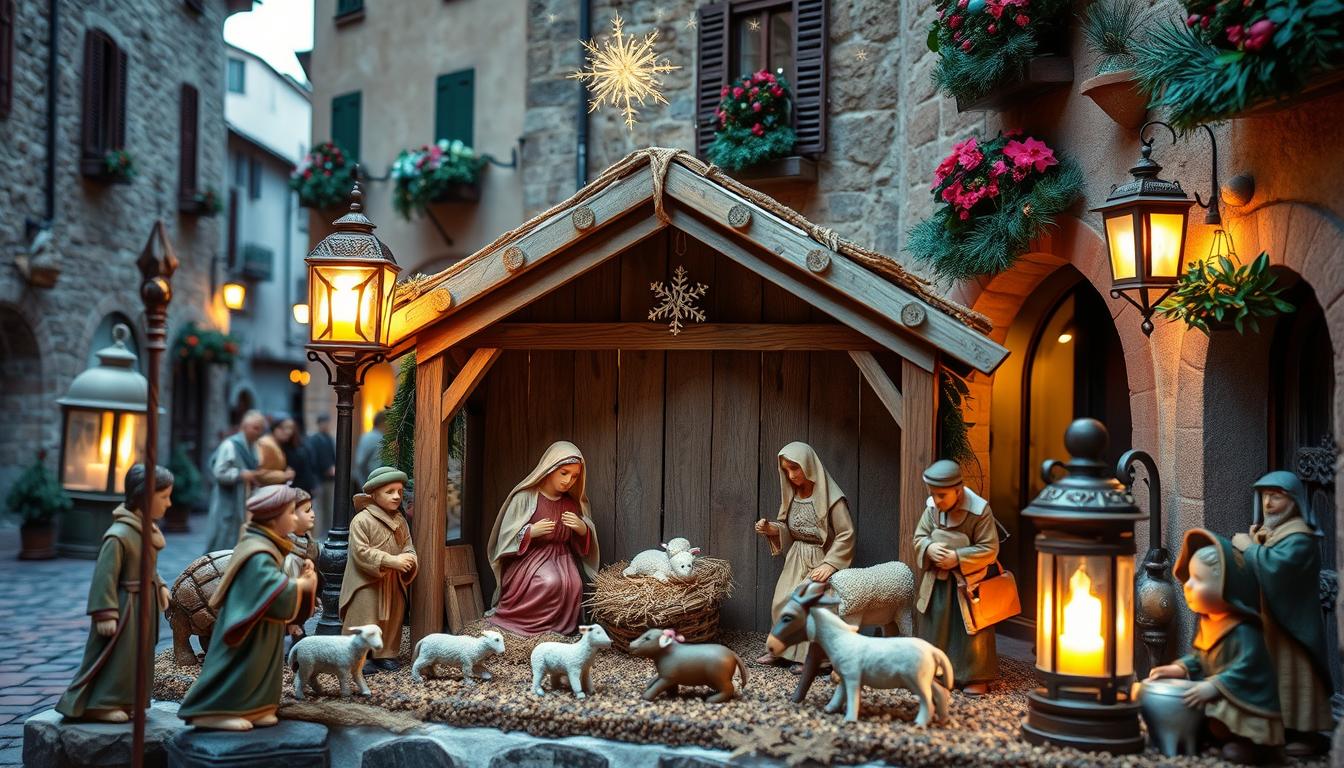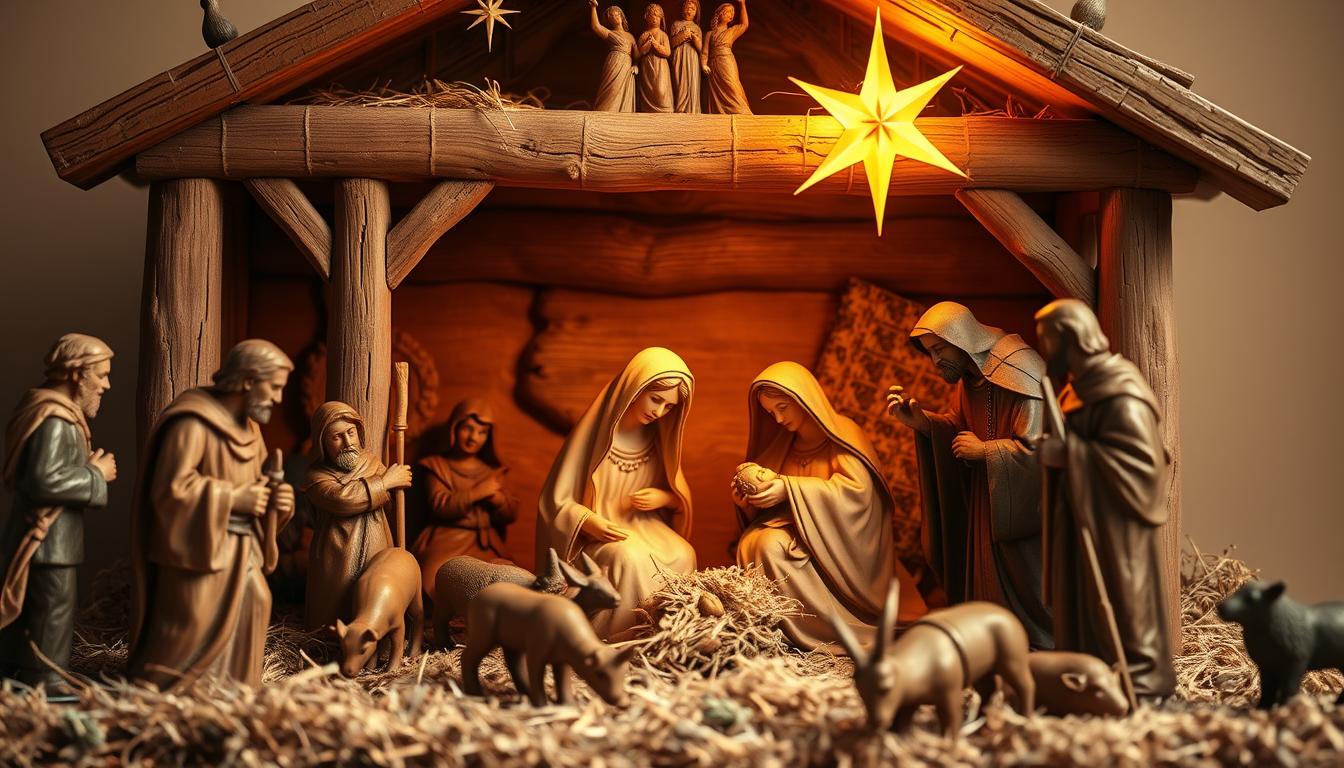As the holidays get closer, we often think back on special traditions. These traditions warm our hearts and bring us closer. In Italy, one beloved tradition is the presepio nativity scene. It’s not just any holiday decoration. It’s a beautiful art piece that tells the story of Christmas in Italy. When you see a nativity scene, you feel a sense of joy and reflection. This happens whether you’re in a cozy home or walking through a charming village during the holidays.
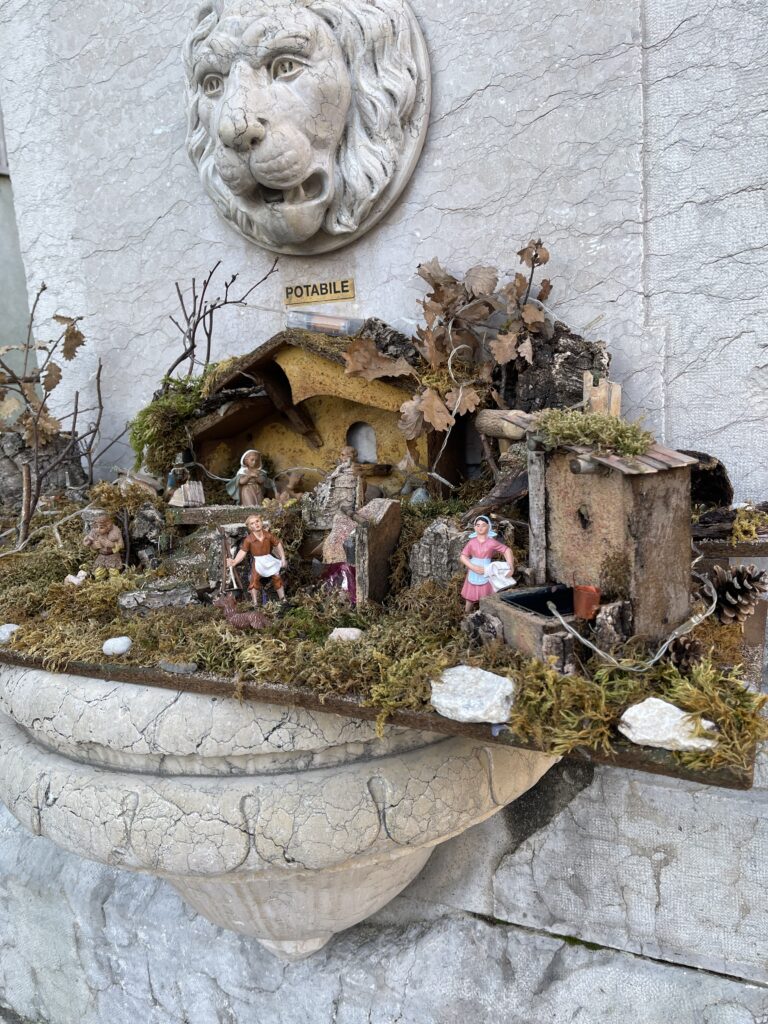
The presepio has a long history, starting in 1223. That’s when St. Francis of Assisi made the first nativity scene. It was Christmas Eve in Greccio. Since then, the presepio has become a key part of the holiday season. It brings together people of all ages. They share in the joy of setting it up, admiring the handiwork, and feeling its deep cultural meaning. You might see a grand scene in a church or a simple one in someone’s home. Either way, the nativity connects us to our faith, our families, and the spirit of giving that defines the season.
Key Takeaways
- The tradition of the nativity scene dates back to 1223, initiated by St. Francis of Assisi.
- Presepio scenes often feature key characters such as Mary, Joseph, and baby Jesus, among others.
- Neapolitan artisans are known for their highly detailed and theatrical presepio figures.
- The tradition of setting up the nativity scene typically begins on December 8th in Italy.
- Figures in the nativity scenes are often passed down through generations, carrying sentimental value.
Introduction to Italian Christmas Traditions
Italian Christmas traditions are full of life, showing the deep culture of the nation. A key part of these festivities is the Presepe, or Nativity scene. It brings families together around a beautiful tradition that’s been around for nearly 1,600 years. The idea started with St. Francis of Assisi in 1223. He reenacted the Nativity, making the Presepe a way for families to connect with their Italian roots.

Christmas preparations kick off on December 8, the Feast of the Immaculate Conception. Some families start even earlier, on November 29, to begin the Immaculate Conception novena. They keep the Presepe up until late January or February. This long tradition lets families celebrate their heritage and the story of Jesus’ birth for an extended time.
The Presepe is not just found in homes but also in churches and public spaces. It’s a central part of the Italian Christmas. Families add special pieces to their Nativity scenes over the years. These personal touches tell unique stories. They not only display Italian artistry but also keep the spirit of the holiday alive.
The Origin of the Presepio Nativity Scene in Italy
The history of presepio in Italy started in 1223. St. Francis of Assisi made the first nativity scene in Greccio. It had live animals and human figures to show Jesus’ birth simply. This new idea quickly became popular. It spread through Italy and then to other parts of Europe. The styles and forms of nativity scenes evolved over time.
Nativity scenes became more than simple setups by the 18th century. In Naples, artisans started making the famous Neapolitan presepi. These detailed displays included holy figures and scenes of daily life. You would see Italian markets, hunters, and merchants. Such scenes made the nativity story more relatable to people.
From the 1700s, the art of making presepi flourished. Artisans used terracotta and paper mache for more detailed figures. Public and private nativity displays became very elaborate. These scenes connect spirituality with culture, a link to St. Francis of Assisi‘s simple beginning.
In places like San Gregorio Armeno in Naples, this tradition is still strong today. You can see workshops full of artisans. Modern influences have crept into nativity scenes with contemporary figures. This shows the presepio’s lasting importance and ability to adapt.

Understanding the Significance of the Presepio Nativity Scene in Italy
The presepio nativity scene is key in Italian culture, beyond just decoration. It tells stories, traditions, and beliefs from Italian spirituality. These displays bring the Christmas story to life. They let families connect with their heritage and faith during the holidays.
The presepi showcase figures like Mary, Joseph, and baby Jesus with great detail. These scenes also include the three Magi, shepherds, and animals. Life scenes in them show the culture’s value of nativities. They let you see into past lifestyles through art.
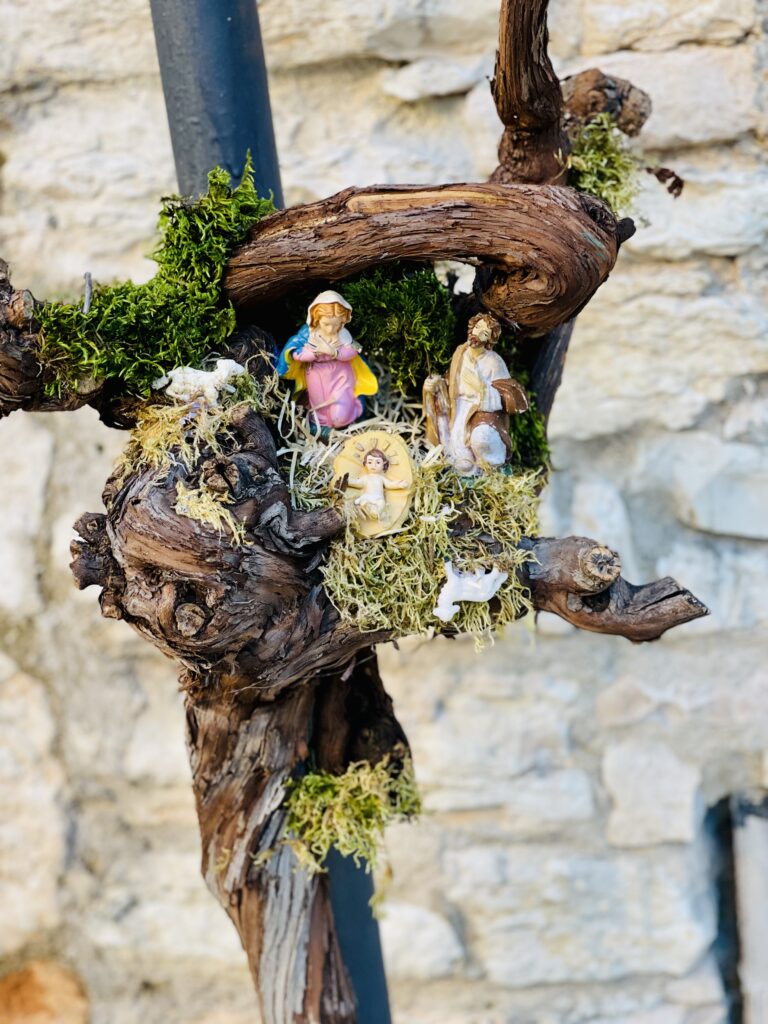
St. Francis of Assisi started this tradition in 1223. By the 18th century, famous Neapolitan artists were making detailed presepio figures for the wealthy. Today, local artists continue this tradition in Naples. They make miniatures of Italian markets that are sold in holiday markets.
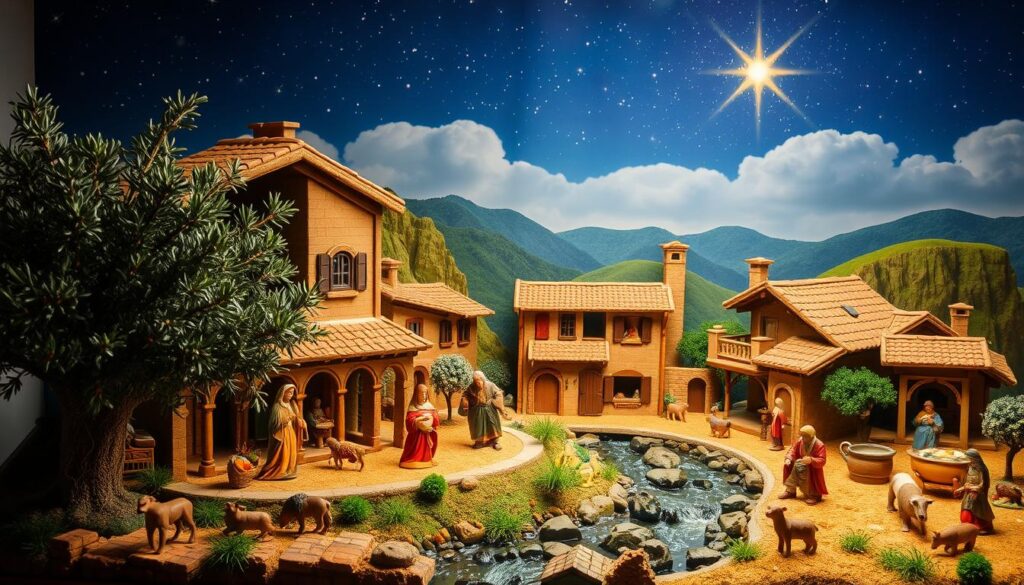
On Christmas Eve, it’s traditional to place baby Jesus in the crib at midnight. This act symbolizes hope and light coming into the world. Displays vary from simple ones in homes and churches to intricate public square scenes. Some places have living nativities, where people act out the story. This makes the experience more immersive and festive.
Nativity scenes are more than pretty decorations; they show a deep love for family, faith, and tradition. Italy is full of presepi during Christmas. From the Vatican’s grand displays to unique floating scenes on the coast, each has its own story. They invite you into the magic of Italian Christmas celebrations.
Celebrating the Presepe Family Tradition
Setting up the presepe starts the Christmas season on December 8th in Italy. Families gather to bring out cherished figures. This brings back memories and strengthens family bonds.
This tradition is more than creativity. It unites families as they share in building a display. This display stays up until January 6th, the Epiphany.
Setting Up the Presepe: A Family Ritual
Creating a presepe means placing nativity scene characters carefully. Characters like Mary, Joseph, the Magi, and shepherds tell a story. Especially those passed down through generations.
Key Figures and Characters in the Presepe
The heart of this tradition is the nativity scene characters. Important characters include:
- Mary
- Joseph
- Baby Jesus
- Shepherds
- The Three Magi
These characters bring the nativity story to life. Families talk about each figure’s meaning as they place them. Everyone’s involvement turns setting up the presepe into a real celebration of family traditions in Italy.
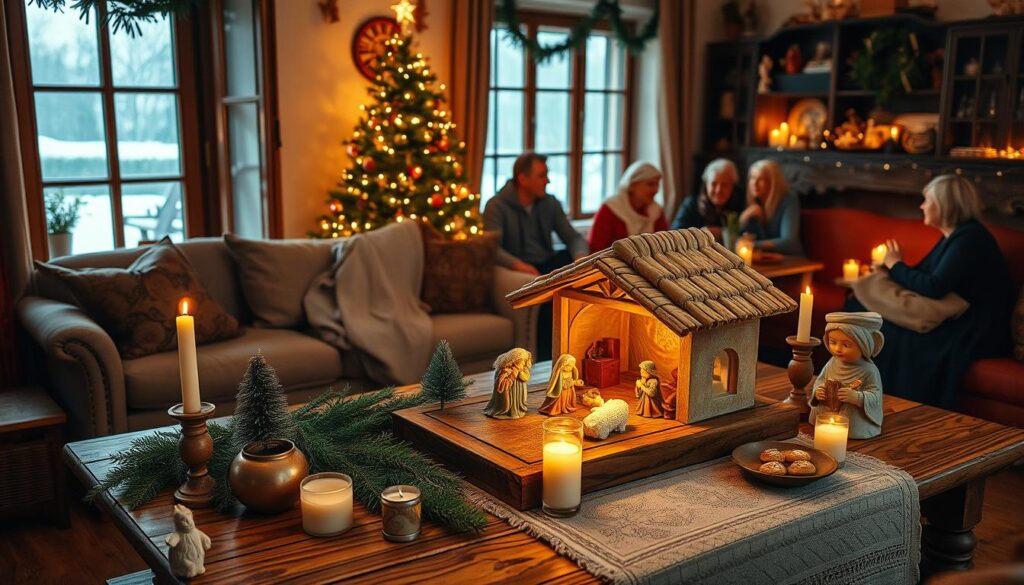
The Artistic Craftsmanship of Neapolitan Presepi
The Neapolitan presepi are a key part of Italy’s rich art history. These nativity scenes show the Christmas spirit through the work of skilled artists. They not only show the holy birth but also tell stories of culture in every detail.
The Role of Artisans in Creating Nativity Scenes
For over 150 years, Naples’ artisans have been honing their skills. They follow a tradition over 1,500 years old. Saint Francis of Assisi started this tradition in 1223.
In Naples, the workshops on Via San Gregorio Armeno are full of dedication. Here, artists like Ferrigno and Fratelli Capuano create lifelike figures. These figures include both biblical and everyday characters, and even those from current events.
Intricate Designs and Materials Used
The craft behind Neapolitan presepi is amazing. Artists use wood, terracotta, clay, and linden wood for their creations. They make detailed city and landscape scenes, adding lights and motion for realism.
This blend of creativity and tradition makes each scene unique. The artists not only show the holy family but also bring to life Naples’ culture. This turns each presepi into a vivid story of the local heritage.
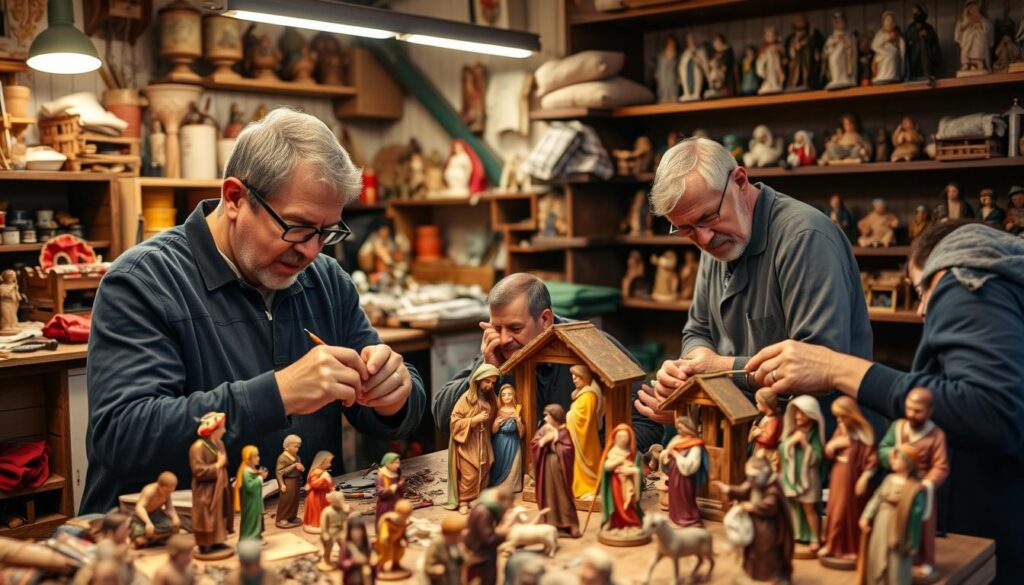
The Unique Elements of a Neapolitan Presepe
The Neapolitan presepe is a blend of art, culture, and history. It shows not only Jesus’ birth but also daily life in 18th-century Naples. These scenes have lively characters and lots of details.
Everyday Life and Historical Context in the Scene
Each Neapolitan presepe is like a picture of olden times. It includes people like bakers and fishermen. This shows you the culture of Naples beyond the religious story. It brings to life markets and families, making the scenes stand out.
Dynamic Features and Immersive Experiences
The presepe today has new features that make it really special. There’s running water, lights, and moving parts. These additions make the whole scene feel alive. It’s a mix of creativity and modern touches that truly captivates.
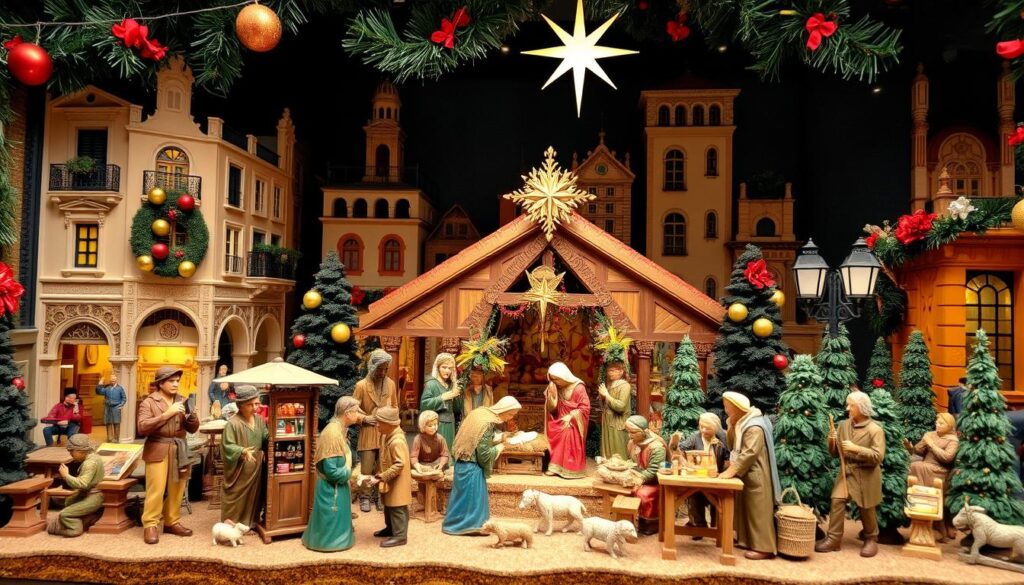
| Element | Description | Impact |
|---|---|---|
| Figures | Characters representing various roles in 18th-century Naples | Showcases the social fabric of the time |
| Dynamic Features | Incorporation of running water, lights, and movement | Creates an immersive viewing experience |
| Market Scenes | Miniature recreations of traditional Italian markets | Enhances storytelling through cultural representation |
Visiting Via San Gregorio Armeno: The Heart of Presepi
Walking through Via San Gregorio Armeno in Naples is magical. This street is the center of presepi art, filled with master craftsmen. During Christmas, its atmosphere becomes even more special. Artisans bring the tradition of nativity scenes to life. Their skill and imagination light up the area.
The Tradition of Craftsmanship in Naples
Artisans in Naples work all year, honing their craft with age-old techniques. They sculpt and paint by hand, creating both biblical and modern figures. You’ll see everything from traditional scenes to characters from today’s culture. Their dedication ensures each nativity piece is unique and meaningful.
Buying these nativity scenes is an experience like no other. It’s a way to connect with Naples’ rich traditions and support local artists.
Shopping for Unique Presepi Items
Shopping on Via San Gregorio Armeno means more than just finding gifts. It’s about meeting the artists and appreciating their work. The street is home to many small shops, each with its own treasures. In December, the festive spirit is everywhere, making it a great time to visit.
To avoid crowds, try going in the early morning or late afternoon. This is when you can quietly explore and see the artisans at work. Their incredible creations are sure to impress.
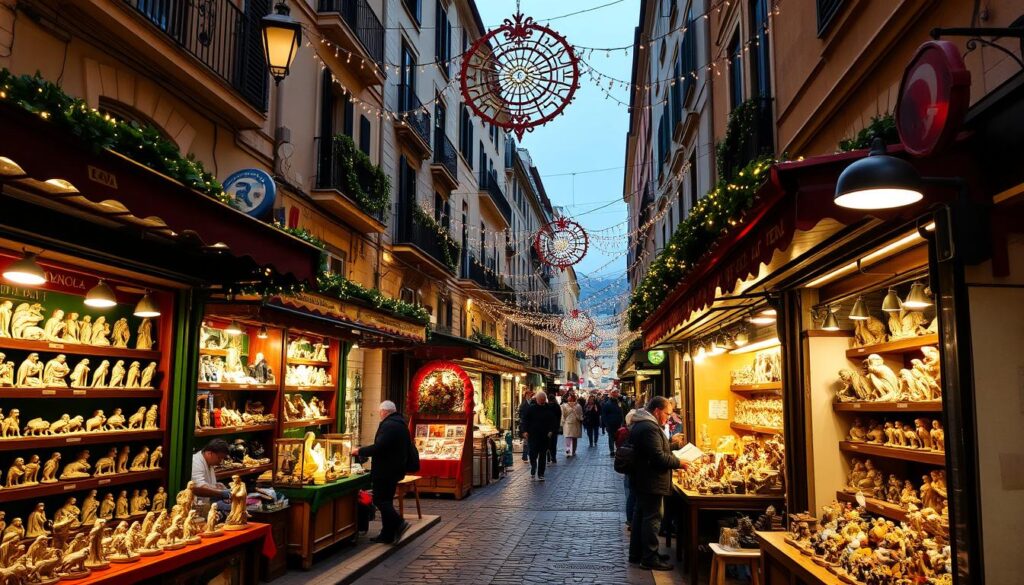
Modern Adaptations of the Presepio Nativity Scene in Italy
The presepio tradition has entered a new era with modern updates. Nowadays, nativity scenes mirror today’s values and shifts in culture. These changes let families display stories they can relate to. Artists and families now add figures in current fashions, religious icons, and important historical figures. Such updates make these stories fresh while keeping their original spirit.
Incorporating Contemporary Figures and Themes
The way we tell the nativity story is changing to stay relevant. Modern nativity scenes mix traditional figures with elements from today’s world. This helps people connect the story’s roots with their own lives. Examples of these modern elements include:
- Inclusion of local community leaders to underline the role of faith in modern society.
- Showing families in present-day settings to reflect today’s social dynamics.
- Bringing in local cultural symbols, showing off Italy’s diverse culture.
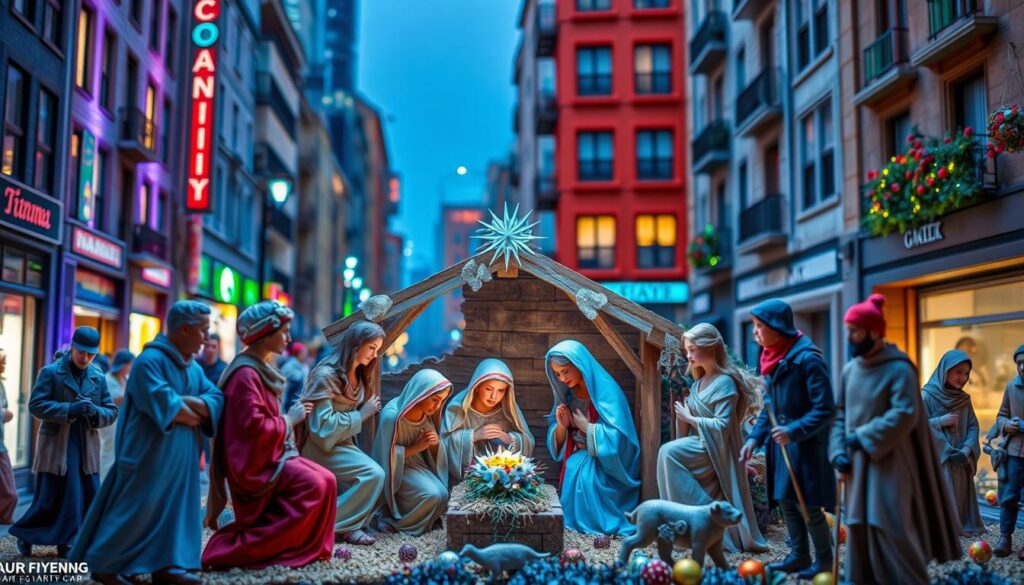
By merging old and new, Italy keeps its nativity scene tradition vibrant. This trend lets artists innovate while honoring the presepio’s beginnings. It ensures the tradition thrives, prompting conversations on faith, culture, and family values for future generations.
Conclusion
The presepio nativity scene is very important for Italian Christmas. It started in the early 13th century with Saint Francis of Assisi. He made the first Nativity scene. This beautiful tradition has grown over time, especially in Naples.
Nativity scenes show life from the past, including everyday activities and important religious stories. This mix makes the presepio more meaningful. When families come together to set up their nativity scenes, they are doing more than decorating. They are making new memories that connect them through time.
The presepio keeps evolving, adding new figures to stay current. It invites everyone to look closer and enjoy its story. You might see the detailed work on Via San Gregorio Armeno or take part in local customs. The presepio highlights Italy’s deep cultural history, making Italian Christmas celebrations unique.
